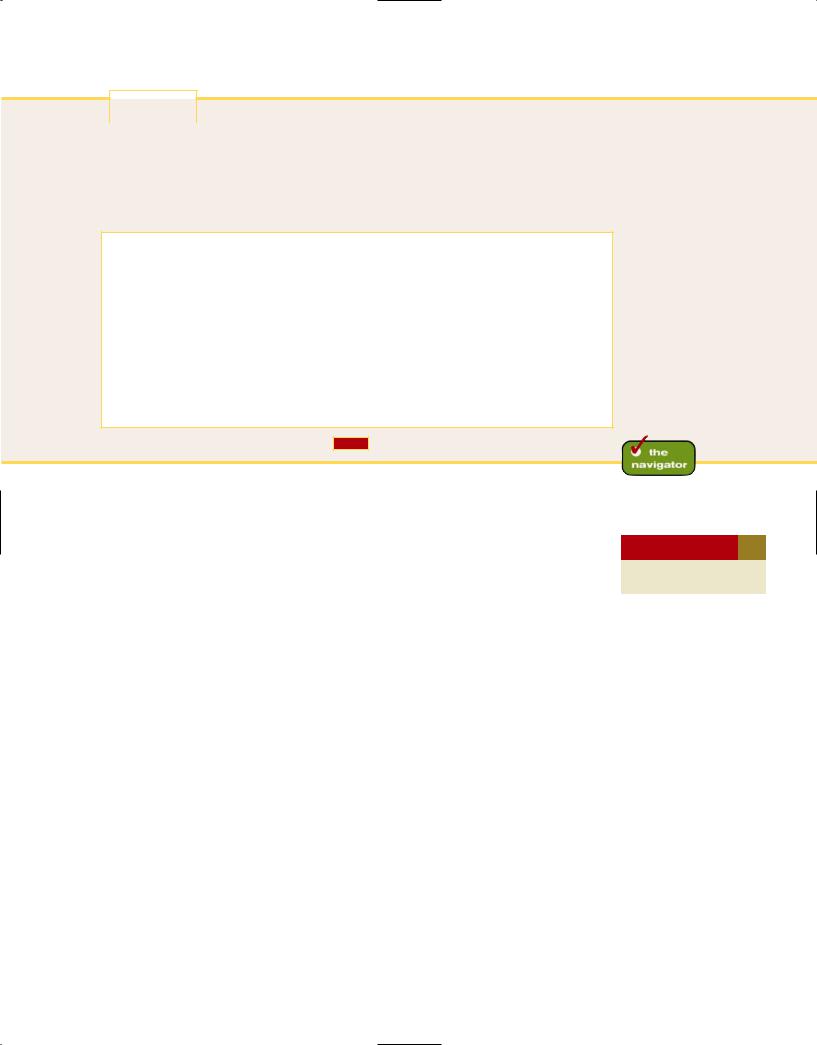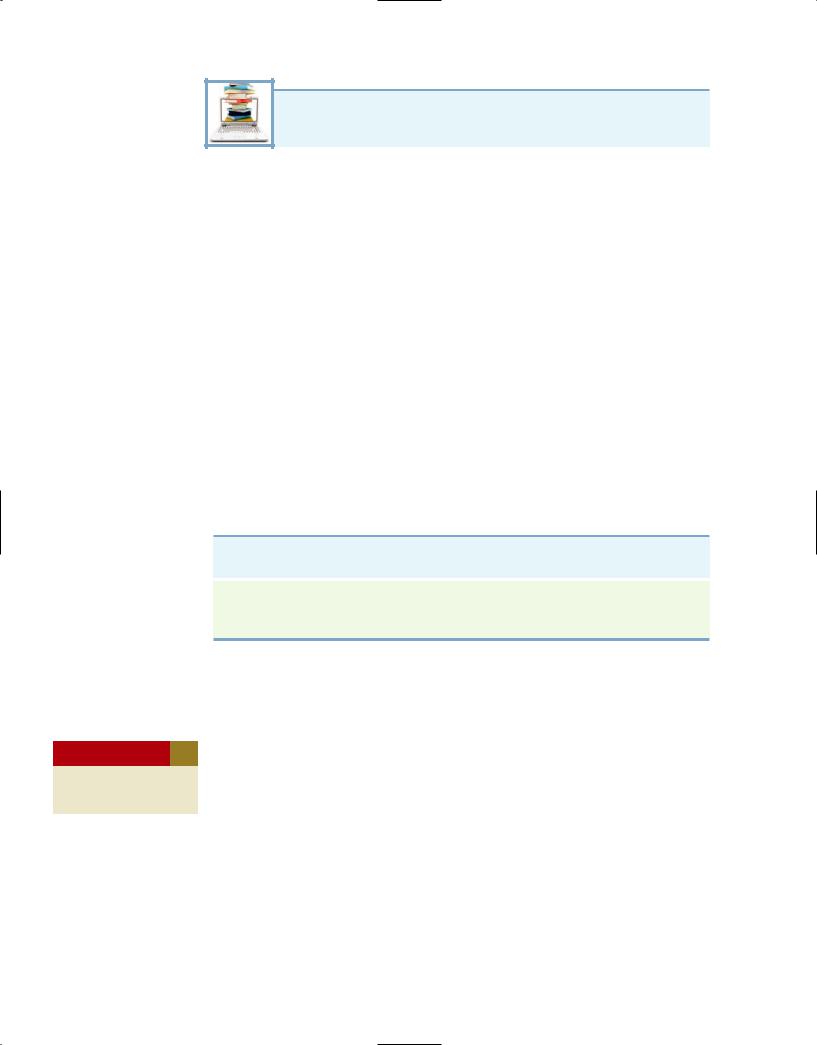
Финансовый учет. Ридер
.pdf
220
584 chapter 11 Reporting and Analyzing Stockholders’ Equity
study objective 5
Prepare the entries for cash dividends and understand the effect of stock dividends and stock splits.
Dividends
As noted earlier, a dividend is a distribution by a corporation to its stockholders on a pro rata (proportional to ownership) basis. Pro rata means that if you own, say, 10% of the common shares, you will receive 10% of the dividend. Dividends can take four forms: cash, property, scrip (promissory note to pay cash), or stock. Cash dividends, which predominate in practice, and stock dividends, which are declared with some frequency, are the focus of our discussion.
Investors are very interested in a company’s dividend practices. In the financial press, dividends are generally reported quarterly as a dollar amount per share. (Sometimes they are reported on an annual basis.) For example, Nike’s quarterly dividend rate in the fourth quarter of 2006 was 15.5 cents per share; the dividend rate for the fourth quarter of 2007 for GE was 31 cents, and for ConAgra Foods it was 18 cents.
CASH DIVIDENDS
A cash dividend is a pro rata (proportional to ownership) distribution of cash to stockholders. Cash dividends are not paid on treasury shares. For a corporation to pay a cash dividend, it must have the following.
1.Retained earnings. Payment of dividends from retained earnings is legal in all states. In addition, loan agreements frequently constrain companies to pay dividends only from retained earnings. Many states prohibit payment of dividends from legal capital. However, payment of dividends from paid-in capital in excess of par is legal in some states.
2.Adequate cash. Recently, Nike had a balance in retained earnings of $5,451 million but a cash balance of only $2,291 million. If it had wanted to pay a dividend equal to its retained earnings, Nike would have had to raise $3,160 million more in cash. It would have been unlikely to do this because it would not be able to pay this much in dividends in future years. In addition, such a dividend would completely deplete Nike’s balance in retained earnings, so it would not be able to pay a dividend in the next year unless it had positive net income.
3.Declared dividends. The board of directors has full authority to determine the amount of income to distribute in the form of dividends. Dividends are not a liability until they are declared.
The amount and timing of a dividend are important issues for management to consider. The payment of a large cash dividend could lead to liquidity problems for the company. Conversely, a small dividend or a missed dividend may cause unhappiness among stockholders who expect to receive a reasonable cash payment from the company on a periodic basis. Many companies declare and pay cash dividends quarterly. On the other hand, a number of high-growth companies pay no dividends, preferring to conserve cash to finance future capital expenditures.
Investors must keep an eye on the company’s dividend policy and understand what it may mean. For most companies, for example, regular dividend boosts in the face of irregular earnings can be a warning signal. Companies with high dividends and rising debt may be borrowing money to pay shareholders. On the other hand, low dividends may not be a negative sign because it may mean the company is reinvesting in itself, which may result in high returns through increases in the stock price. Presumably, investors seeking regular dividends buy stock in companies that pay periodic dividends, and those seeking growth in the stock price (capital gains) buy stock in companies that retain their earnings rather than pay dividends.

221
Entries for Cash Dividends
Three dates are important in connection with dividends: (1) the declaration date,
(2) the record date, and (3) the payment date. Companies make accounting entries on the declaration date and the payment date.
On the declaration date, the board of directors formally authorizes the cash dividend and announces it to stockholders. The declaration of a cash dividend commits the corporation to a binding legal obligation. Thus, the company must make an entry to recognize the increase in Cash Dividends and the increase in the liability Dividends Payable.
To illustrate, assume that on December 1, 2012, the directors of Media General declare a $0.50 per share cash dividend on 100,000 shares of $10 par value common stock. The dividend is $50,000 (100,000 $0.50). The entry to record the declaration is:
Declaration Date |
|
Dec. 1 Cash Dividends |
50,000 |
Dividends Payable |
50,000 |
(To record declaration of cash dividend) |
|
In Chapter 3, we used an account called Dividends to record a cash dividend. Here, we use the more specific title Cash Dividends to differentiate from other types of dividends, such as stock dividends. Dividends Payable is a current liability: It will normally be paid within the next several months.
At the record date, the company determines ownership of the outstanding shares for dividend purposes. The stockholders’ records maintained by the corporation supply this information.
For Media General, the record date is December 22. No entry is required on the record date.
Record Date
Dec. 22 No entry necessary
Dividends 585
A = L + SE
50,000 Div50,000
Cash Flows no effect
Helpful Hint The record date is important in determining the dividend to be paid to each stockholder.
On the payment date, the company makes cash dividend payments to the stockholders on record as of December 22, and it also records the payment of the dividend. If January 20 is the payment date for Media General, the entry on that date is:
Payment Date
|
|
|
|
|
|
A = L + SE |
Jan. 20 |
|
Dividends Payable |
|
50,000 |
|
50,000 |
|
|
|
||||
|
|
Cash |
|
|
50,000 |
50,000 |
|
|
(To record payment of cash dividend) |
|
|
|
|
|
|
|
|
|
Cash Flows |
|
|
|
|
|
|||
|
|
|
|
|
|
|
|
|
|
|
|
|
50,000 |
Note that payment of the dividend on the payment date reduces both current assets and current liabilities, but it has no effect on stockholders’ equity. The cumulative effect of the declaration and payment of a cash dividend on a company’s financial statements is to decrease both stockholders’ equity and total assets.
STOCK DIVIDENDS
A stock dividend is a pro rata (proportional to ownership) distribution of the corporation’s own stock to stockholders. Whereas a cash dividend is paid in cash, a stock dividend is paid in stock. A stock dividend results in a decrease in retained earnings and an increase in paid-in capital. Unlike a cash dividend, a stock dividend does not decrease total stockholders’ equity or total assets.

222
586 chapter 11 Reporting and Analyzing Stockholders’ Equity
Because a stock dividend does not result in a distribution of assets, some view it as nothing more than a publicity gesture. Stock dividends are often issued by companies that do not have adequate cash to issue a cash dividend. These companies may not want to announce that they are not going to be issuing a cash dividend at their normal time to do so. By issuing a stock dividend, they “save face” by giving the appearance of distributing a dividend. Note that since a stock dividend neither increases nor decreases the assets in the company, investors are not receiving anything they didn’t already own. In a sense, it is like asking for two pieces of pie and having your host take one piece of pie and cut it into two smaller pieces. You are not better off, but you got your two pieces of pie.
To illustrate a stock dividend, assume that you have a 2% ownership interest in Cetus Inc.; you own 20 of its 1,000 shares of common stock. If Cetus declares a 10% stock dividend, it would issue 100 shares (1,000 10%) of stock. You would receive two shares (2% 100), but your ownership interest would remain at 2% (22 1,100). You now own more shares of stock, but your ownership interest has not changed. Moreover, the company disburses no cash and assumes no liabilities.
What, then, are the purposes and benefits of a stock dividend? Corporations generally issue stock dividends for one of the following reasons.
1.To satisfy stockholders’ dividend expectations without spending cash.
2.To increase the marketability of the stock by increasing the number of shares outstanding and thereby decreasing the market price per share. Decreasing the market price of the stock makes it easier for smaller investors to purchase the shares.
3.To emphasize that the company has permanently reinvested in the business a portion of stockholders’ equity, which therefore is unavailable for cash dividends.
When the dividend is declared, the board of directors determines the size of the stock dividend and the value per share to use to record the transaction. In order to meet legal requirements, the per share amount must be at least equal to the par or stated value.
The accounting profession distinguishes between a small stock dividend (less than 20%–25% of the corporation’s issued stock) and a large stock dividend (greater than 20%–25%). It recommends that the company use the fair value per share to record small stock dividends. The recommendation is based on the assumption that a small stock dividend will have little effect on the market price of the shares previously outstanding. Thus, many stockholders consider small stock dividends to be distributions of earnings equal to the fair value of the shares distributed. The accounting profession does not specify the value to use to record a large stock dividend. However, companies normally use par or stated value per share. Small stock dividends predominate in practice. In the appendix at the end of the chapter, we illustrate the journal entries for small stock dividends.
Effects of Stock Dividends
Helpful Hint Because of its effects, a stock dividend is also referred to as capitalizing retained earnings.
How do stock dividends affect stockholders’ equity? They change the composition of stockholders’ equity because they result in a transfer of a portion of retained earnings to paid-in capital. However, total stockholders’ equity remains the same. Stock dividends also have no effect on the par or stated value per share, but the number of shares outstanding increases.
Illustration 11-9 shows the effects that result when Medland Corp. declares a 10% stock dividend on its $10 par common stock when 50,000 shares were outstanding. The market price was $15 per share.

223
|
|
|
|
|
|
|
|
|
|
|
Dividends |
587 |
|
|
|
|
|
|
|
|
|
|
|
Illustration 11-9 |
Stock |
|
|
Before |
|
|
|
|
|
After |
||||
|
|
|
|
|
|
|
dividend effects |
|
||||
|
Dividend |
|
Change |
|
Dividend |
|
||||||
|
|
|
|
|
||||||||
Stockholders’ equity |
|
|
|
|
|
|
|
|
|
|
|
|
Paid-in capital |
|
|
|
|
|
|
|
|
|
|
|
|
Common stock, $10 par |
$ 500,000 |
|
|
|
|
|
$ 550,000 |
|
|
|
||
Paid-in capital in excess of par value |
|
— |
|
|
|
|
25,000 |
|
|
|
||
Total paid-in capital |
|
500,000 |
|
$75,000 |
|
575,000 |
|
|
|
|||
Retained earnings |
|
300,000 |
|
75,000 |
225,000 |
|
|
|
||||
|
|
|
|
|
|
|
|
|
|
|
|
|
Total stockholders’ equity |
$800,000 |
|
$ |
0 |
$800,000 |
|
|
|
||||
|
|
|
|
|
|
|
|
|
|
|
|
|
Outstanding shares |
50,000 |
|
|
5,000 |
55,000 |
|
|
|
||||
|
|
|
|
|
|
|
|
|
|
|
|
|
|
|
|
|
|
|
|
|
|
|
|
|
|
In this example, total paid-in capital increased by $75,000 (50,000 shares 10% $15), and retained earnings decreased by the same amount. Note also that total stockholders’ equity remains unchanged at $800,000. The number of shares increases by 5,000 (50,000 10%).
STOCK SPLITS
A stock split, like a stock dividend, involves the issuance of additional shares of stock to stockholders according to their percentage ownership. However, a stock split results in a reduction in the par or stated value per share. The purpose of a stock split is to increase the marketability of the stock by lowering its market value per share. This, in turn, makes it easier for the corporation to issue additional stock. After hitting a peak of 114 stock splits in 1986, the number of splits in the United States has fallen to about 30 per year. Nike was one of the few firms to split in 2007. It justified the action by noting that its stock price had increased by 70% during the previous five years.
Like a stock dividend, a stock split increases the number of shares owned by a shareholder, but it does not change the percentage of the total company that the shareholder owns. The effects of a 3-for-1 split are shown in Illustration 11-10.
Helpful Hint A stock split changes the par value per share but does not affect any balances in stockholders’ equity.
Before stock dividend |
After stock dividend |
or split |
or split |
10 |
10 |
10 |
10 |
10 |
10 |
|
shares |
shares |
10 |
10 |
10 |
10 |
|
10 |
10 |
|||||
10 |
10 |
10 |
10 |
|||
shares |
shares |
Number of shares owned increases, but percentage of company owned remains the same.
“I owned 40 shares before and I own 120 shares now, but I still
own only 1⁄4 of the company!”
Illustration 11-10 Effect of stock dividend or stock split for stockholders
The effect of a split on market value is generally inversely proportional to the size of the split. For example, after a recent 2-for-1 stock split, the market value of Nike’s stock fell from $111 to approximately $55.

224
588 chapter 11 Reporting and Analyzing Stockholders’ Equity
Investor Insight
A No-Split Philosophy
Warren Buffett’s company, Berkshire Hathaway, has two classes of shares. Until recently, the company had never split either class of stock. As a result, the class A stock had a market price of $97,000 and the class B sold for about $3,200 per share. Because the price per share is so high, the stock does not trade as frequently as the stock of other companies. Mr. Buffett has always opposed stock splits because he feels that a lower stock price attracts short-term investors. He appears to be correct. For example, while more than 6 million shares of IBM are exchanged on the average day, only about 1,000 class A shares of Berkshire are traded. Despite Mr. Buffett’s aversion to splits, in order to accomplish a recent acquisition, Berkshire decided to split its class B shares 50 to 1.
Source: Scott Patterson, “Berkshire Nears Smaller Baby B’s,” Wall Street Journal Online (January 19, 2010).
?Why does Warren Buffett usually oppose stock splits? (See page 619.)
In a stock split, the company increases the number of shares in the same proportion that it decreases the par or stated value per share. For example, in a 2-for-1 split, the company exchanges one share of $10 par value stock for two shares of $5 par value stock. A stock split does not have any effect on paidin capital, retained earnings, and total stockholders’ equity. However, the number of shares outstanding increases. The effects of a 2-for-1 stock split of Medland Corporation’s common stock are shown in Illustration 11-11.
Illustration 11-11 Stock |
|
|
Before |
|
|
|
|
|
|
|
After |
|||
split effects |
|
|
|
|
|
|
|
|
|
|||||
|
Stock Split |
Change |
Stock Split |
|||||||||||
|
|
|||||||||||||
|
Stockholders’ equity |
|
|
|
|
|
|
|
|
|
|
|
|
|
|
Paid-in capital |
|
|
|
|
|
|
|
|
|
|
|
|
|
|
Common stock |
|
|
|
|
|
|
|
|
|
|
|
|
|
|
(before: 50,000 $10 par shares; |
|
|
|
|
|
|
|
|
|
|
|
|
|
|
after: 100,000 $5 par shares) |
$ 500,000 |
|
|
|
|
|
|
$ 500,000 |
|
||||
|
Paid-in capital in excess of par value |
0 |
|
|
|
|
|
|
|
0 |
|
|||
|
|
|
|
|
|
|
|
|
|
|
|
|
|
|
|
Total paid-in capital |
500,000 |
|
$ |
0 |
|
500,000 |
|
||||||
|
Retained earnings |
300,000 |
|
|
|
|
0 |
300,000 |
|
|||||
|
|
|
|
|
|
|
|
|
|
|
|
|
|
|
|
Total stockholders’ equity |
$800,000 |
|
$ |
0 |
$800,000 |
|
|||||||
|
|
|
|
|
|
|
|
|
|
|
|
|
||
|
Outstanding shares |
50,000 |
|
50,000 |
100,000 |
|
||||||||
|
|
|
|
|
|
|
|
|
|
|
|
|
|
|
|
|
|
|
|
|
|
|
|
|
|
|
|
|
|
Illustration 11-12
Effects of stock splits and stock dividends differentiated
Because a stock split does not affect the balances in any stockholders’ equity accounts, a company does not need to journalize a stock split. However, a memorandum entry explaining the effect of the split is typically made.
The differences between the effects of stock dividends and stock splits are shown in Illustration 11-12.
|
Item |
|
Stock Dividend |
Stock Split |
||
|
|
|
|
|
|
|
|
Total paid-in capital |
|
Increase |
No change |
||
|
Total retained earnings |
Decrease |
No change |
|||
|
Total par value (common stock) |
Increase |
No change |
|||
|
Par value per share |
No change |
Decrease |
|||
|
|
|
|
|
|
|

225
Retained Earnings 589
before you go on...
 Due to five years of record earnings at Sing CD Corporation, the market price of its 500,000 shares of $2 par value common stock tripled from $15 per share to $45. During this period, paid-in capital remained the same at $2,000,000. Retained earnings increased from $1,500,000 to $10,000,000. President Joan Elbert is considering either a 10% stock dividend or a 2-for-1 stock split. She asks you to show the before and after effects of each option on retained earnings.
Due to five years of record earnings at Sing CD Corporation, the market price of its 500,000 shares of $2 par value common stock tripled from $15 per share to $45. During this period, paid-in capital remained the same at $2,000,000. Retained earnings increased from $1,500,000 to $10,000,000. President Joan Elbert is considering either a 10% stock dividend or a 2-for-1 stock split. She asks you to show the before and after effects of each option on retained earnings.
Solution
The stock dividend amount is $2,250,000 [(500,000 10%) $45]. The new balance in retained earnings is $7,750,000 ($10,000,000 $2,250,000). The retained earnings balance after the stock split is the same as it was before the split: $10,000,000. The effects on the stockholders’ equity accounts are as follows.
|
|
Original |
|
|
After |
|
|
After |
|
|
|
Balances |
|
Dividend |
|
|
|
Split |
|
Paid-in capital |
$ 2,000,000 |
$ |
4,250,000 |
$ |
2,000,000 |
||||
Retained earnings |
10,000,000 |
|
|
7,750,000 |
|
|
10,000,000 |
||
|
|
|
|
|
|
|
|
||
Total stockholders’ equity |
$12,000,000 |
$12,000,000 |
$12,000,000 |
||||||
|
|
|
|
|
|
|
|
|
|
|
|
|
|
|
|
|
|
|
|
Shares outstanding |
500,000 |
|
|
550,000 |
|
|
1,000,000 |
||
|
|
|
|
|
|
|
|
|
|
Related exercise material: BE11-6, BE11-7, Do it! 11-5, and E11-7.
STOCK DIVIDENDS; STOCK SPLITS
Action Plan
•Calculate the stock dividend’s effect on retained earnings by multiplying the number of new shares times the market price of the stock (or par value for a large stock dividend).
•Recall that a stock dividend increases the number of shares without affecting total equity.
•Recall that a stock split only increases the number of shares outstanding and decreases the par value per share without affecting total equity.
Retained Earnings
Retained earnings is net income that a company retains in the business. The balance in retained earnings is part of the stockholders’ claim on the total assets of the corporation. It does not, however, represent a claim on any specific asset. Nor can the amount of retained earnings be associated with the balance of any asset account. For example, a $100,000 balance in retained earnings does not mean that there should be $100,000 in cash. The reason is that the company may have used the cash resulting from the excess of revenues over expenses to purchase buildings, equipment, and other assets. Illustration 11-13 shows recent amounts of retained earnings and cash in selected companies.
|
|
|
|
|
(in millions) |
|
|||
|
|
|
Retained |
|
|
|
|||
|
Company |
|
|
Earnings |
|
Cash |
|
||
|
$20,082 |
|
$10,198 |
||||||
|
Nike, Inc. |
4,885 |
|
1,855 |
|||||
|
Starbucks Coffee Company |
2,189 |
|
281 |
|||||
|
Amazon.com |
(1,375) |
|
2,539 |
|||||
|
|
|
|
|
|
|
|
|
|
study objective 6
Identify the items that affect retained earnings.
Illustration 11-13
Retained earnings and cash balances
When expenses exceed revenues, a net loss results. In contrast to net income, a net loss decreases retained earnings. In closing entries, a company debits a net loss to the Retained Earnings account. It does not debit net losses to paid-in capital accounts. To do so would destroy the distinction between paid-in and earned capital. If cumulative losses exceed cumulative income over a company’s life, a debit balance in Retained Earnings results. A debit balance in Retained Earnings, such as that of Amazon.com in a recent year, is a deficit. A company reports a deficit as a deduction in the stockholders’ equity section of the balance sheet, as shown in Illustration 11-14 (page 590).

226
590 chapter 11 Reporting and Analyzing Stockholders’ Equity
Illustration 11-14
Stockholders’ equity with deficit
AMAZON.COM
Balance Sheet (partial) (in millions)
Stockholders’ equity |
|
|
|
|
Paid-in capital |
|
|
|
|
Common stock |
$ |
4 |
|
|
Paid-in capital in excess of par value |
|
|
3,068 |
|
Total paid-in capital |
|
|
3,072 |
|
Accumulated deficit |
(1,375) |
|||
Total paid-in capital and retained earnings |
|
|
1,697 |
|
Less: Treasury stock |
|
|
500 |
|
Total stockholders’ equity |
$1,197 |
|
||
|
|
|
|
|
RETAINED EARNINGS RESTRICTIONS
Illustration 11-15
Disclosure of unrestricted retained earnings
The balance in retained earnings is generally available for dividend declarations. Some companies state this fact. In some circumstances, however, there may be retained earnings restrictions. These make a portion of the balance currently unavailable for dividends. Restrictions result from one or more of these causes: legal, contractual, or voluntary.
Companies generally disclose retained earnings restrictions in the notes to the financial statements. For example, Tektronix Inc., a manufacturer of electronic measurement devices, recently had total retained earnings of $774 million, but the unrestricted portion was only $223.8 million.
TEKTRONIX INC.
Notes to the Financial Statements
Certain of the Company’s debt agreements require compliance with debt covenants. The Company had unrestricted retained earnings of $223.8 million after meeting those requirements.
study objective 7
Prepare a comprehensive stockholders’ equity section.
Financial Statement Presentation
of Stockholders’ Equity
BALANCE SHEET PRESENTATION
In the stockholders’ equity section of the balance sheet, companies report paidin capital and retained earnings and identify the specific sources of paid-in capital. Within paid-in capital, two classifications are recognized:
1.Capital stock, which consists of preferred and common stock. Companies show preferred stock before common stock because of its preferential rights. They report information about the par value, shares authorized, shares issued, and shares outstanding for each class of stock.
2.Additional paid-in capital, which includes the excess of amounts paid in over par or stated value.
Illustration 11-16 presents the stockholders’ equity section of the balance sheet of Graber Inc. The company discloses a retained earnings restriction in the notes. The stockholders’ equity section for Graber Inc. includes most of the accounts discussed in this chapter. The disclosures pertaining to Graber’s common stock indicate that 400,000 shares are issued; 100,000 shares are unissued

227
Financial Statement Presentation of Stockholders’ Equity 591
GRABER INC.
Balance Sheet (partial)
Stockholders’ equity |
|
|
|
Paid-in capital |
|
|
|
Capital stock |
|
|
|
9% preferred stock, $100 par value, cumulative, |
|
|
|
10,000 shares authorized, 6,000 shares issued |
|
|
|
and outstanding |
$ 600,000 |
|
|
Common stock, no par, $5 stated value, |
|
|
|
500,000 shares authorized, 400,000 shares |
|
|
|
issued, and 390,000 outstanding |
2,000,000 |
||
Total capital stock |
2,600,000 |
|
|
Additional paid-in capital |
|
|
|
In excess of par value—preferred stock |
$ 30,000 |
|
|
In excess of stated value—common stock |
1,050,000 |
|
|
Total additional paid-in capital |
|
1,080,000 |
|
Total paid-in capital |
|
3,680,000 |
|
Retained earnings (see Note R) |
1,160,000 |
|
|
Total paid-in capital and retained earnings |
4,840,000 |
|
|
Less: Treasury stock—common (10,000 shares) |
|
(80,000) |
|
Total stockholders’ equity |
|
$4,760,000 |
|
|
|
|
|
Note R: Retained earnings is restricted for the cost of treasury stock, $80,000.
(500,000 authorized less 400,000 issued); and 390,000 shares are outstanding (400,000 issued less 10,000 shares in treasury).
In published annual reports, companies seldom present subclassifications within the stockholders’ equity section. Moreover, they often combine and report as a single amount the individual sources of additional paid-in capital. Notes often provide additional detail. Illustration 11-17 is an excerpt from Procter & Gamble Company’s balance sheet in a recent year.
Illustration 11-16
Comprehensive stockholders’ equity section
International Note Like GAAP, under IFRS companies typically disclose separate categories of capital on the balance sheet. However, because of varying accounting treatments of certain transactions (such as treasury stock or asset revaluations), some categories used under IFRS vary from those under GAAP.
PROCTER & GAMBLE COMPANY
Balance Sheet (partial) (in millions)
Shareholders’ equity |
|
|
|
Convertible Class A preferred stock, stated value |
|
|
|
$1 per share (600 shares authorized) |
$ 1,406 |
||
Non-voting Class B preferred stock, stated value |
|
|
|
$1 per share (200 shares authorized) |
|
— |
|
Common stock, stated value $1 per share |
|
|
|
(10,000 shares authorized; issued: 3,989.7) |
3,990 |
|
|
Additional paid-in capital |
59,030 |
|
|
|
|
|
|
Total paid-in capital |
64,426 |
|
|
Reserve for ESOP debt retirement |
(1,308) |
||
Retained earnings |
41,797 |
|
|
|
|
|
|
Total paid-in capital and retained earnings |
104,915 |
|
|
Accumulated other comprehensive income |
617 |
|
|
Treasury stock, at cost (shares held: 857.8) |
(38,772) |
||
|
|
|
|
Total shareholders’ equity |
$ 66,760 |
|
|
|
|
|
|
Illustration 11-17
Stockholders’ equity section

KEEPING AN EYE
ON CASH
228
The balance sheet presents the balances of a company’s stockholders’ equity accounts at a point in time. Companies report in the “Financing Activities” section of the statement of cash flows information regarding cash inflows and outflows during the year that resulted from equity transactions. The excerpt below presents the cash flows from financing activities from the statement of cash flows of Sara Lee Corporation in a recent year. From this information, we learn that the company’s purchases of treasury stock during the period far exceeded its issuances of new common stock, and its financing activities resulted in a net reduction in its cash balance.
SARA LEE CORPORATION
Statement of Cash Flows (partial) (in millions)
Cash flows from financing activities |
|
|
|
Issuances of common stock |
$ 38 |
||
Purchases of common stock |
(686) |
||
Payments of dividends |
(374) |
||
Borrowings of long-term debt |
2,895 |
||
Repayments of long-term debt |
(416) |
||
Short-term (repayments) borrowings, net |
(1,720) |
||
|
|
|
|
Net cash used in financing activities |
$ (263) |
||
|
|
|
|
before you go on...
STOCKHOLDERS’
EQUITY SECTION
Action Plan
•Present capital stock first; list preferred stock before common stock.
•Present additional paid-in capital after capital stock.
•Report retained earnings after capital stock and additional paid-in capital.
•Deduct treasury stock from total paid-in capital and retained earnings.
 Jennifer Corporation has issued 300,000 shares of $3 par value common stock. It is authorized to issue 600,000 shares. The paid-in capital in excess of par value on the common stock is $380,000. The corporation has reacquired 15,000 shares at a cost of $50,000 and is currently holding those shares.
Jennifer Corporation has issued 300,000 shares of $3 par value common stock. It is authorized to issue 600,000 shares. The paid-in capital in excess of par value on the common stock is $380,000. The corporation has reacquired 15,000 shares at a cost of $50,000 and is currently holding those shares.
The corporation also has 4,000 shares issued and outstanding of 8%, $100 par value preferred stock. It is authorized to issue 10,000 shares. The paid-in capital in excess of par value on the preferred stock is $97,000. Retained earnings is $610,000.
Prepare the stockholders’ equity section of the balance sheet.
Solution
JENNIFER CORPORATION
Balance Sheet (partial)
Stockholders’ equity |
|
|
|
|
|
|
|
Paid-in capital |
|
|
|
|
|
|
|
Capital stock |
|
|
|
|
|
|
|
8% preferred stock, $100 par value, |
|
|
|
|
|
|
|
10,000 shares authorized, 4,000 shares |
|
|
|
|
|
|
|
issued and outstanding |
$ |
400,000 |
|
|
|
|
|
Common stock, $3 par value, 600,000 shares |
|
|
|
|
|
|
|
authorized, 300,000 shares issued, and |
|
|
|
|
|
|
|
285,000 shares outstanding |
|
|
900,000 |
|
|
|
|
|
|
|
|
|
|
|
|
Total capital stock |
1,300,000 |
|
|
|
|
||
Additional paid-in capital |
|
|
|
|
|
|
|
In excess of par value—preferred stock |
|
|
97,000 |
|
|
|
|
In excess of par value—common stock |
|
|
380,000 |
|
|
|
|
Total additional paid-in capital |
|
|
|
$ |
477,000 |
|
|
Total paid-in capital |
|
|
|
1,777,000 |
|
||
Retained earnings |
|
|
|
|
|
610,000 |
|
|
|
|
|
|
|
||
Total paid-in capital and retained earnings |
|
|
2,387,000 |
||||
Less: Treasury stock—common (15,000 shares) |
|
|
|
|
|
|
|
(at cost) |
|
|
|
|
|
(50,000) |
|
|
|
|
|
|
|
||
Total stockholders’ equity |
|
|
$2,337,000 |
|
|||
|
|
|
|
|
|
|
|
Related exercise material: BE11-8, Do it! 11-6, E11-8, E11-9, and E11-10.
592

229
Measuring Corporate Performance 593
Measuring Corporate Performance
Investors are interested in both a company’s dividend record and its earnings performance. Although those two measures are often parallel, that is not always the case. Thus, investors should investigate each one separately.
DIVIDEND RECORD
One way that companies reward stock investors for their investment is to pay them dividends. The payout ratio measures the percentage of earnings a company distributes in the form of cash dividends to common stockholders. It is computed by dividing total cash dividends declared to common shareholders by net income. Using the information shown below, the payout ratio for Nike in 2009 and 2008 is calculated in Illustration 11-18.
study objective 8
Evaluate a corporation’s dividend and earnings performance from a stockholder’s perspective.
|
2009 |
2008 |
Dividends (in millions) |
$ 475.2 |
$ 432.8 |
Net income (in millions) |
1,486.7 |
1,883.4 |
|
|
|
|
|
|
|
|
|
|
|
|
|
|
|
|
|
Payout |
Cash Dividends Declared on Common Stock |
|
||||||||||
|
|
Ratio |
|
|
Net Income |
|
|
|
||||||
|
|
|
|
|
|
|
|
|
|
|
|
|
|
|
|
($ in millions) |
2009 |
|
|
|
2008 |
|
|||||||
|
|
|
|
|
|
|
|
|
|
|
|
|
|
|
|
Payout Ratio |
|
$475.2 |
|
32.0% |
|
|
$432.8 |
23.0% |
|
||||
|
|
|
|
$1,486.7 |
|
|
|
$1,883.4 |
|
|||||
|
|
|
|
|
|
|
|
|
|
|
|
|
|
|
|
The significant increase in Nike’s payout ratio from 23% to 32% resulted from |
Illustration 11-18 Nike’s |
||||||||||||
|
payout ratio |
|||||||||||||
a combination of two factors. First, Nike increased its dividend per share from |
|
|
|
|||||||||||
87.5¢ to 98¢. Second, its net income declined significantly from 2008 to 2009. |
|
|
|
|||||||||||
Nike would probably not have increased its dividend per share unless it believed |
|
|
|
|||||||||||
it could sustain dividends at this level in future years. |
|
|
|
|||||||||||
|
Companies that have high growth rates are characterized by low payout ra- |
|
|
|
||||||||||
tios because they reinvest most of their net income in the business. Thus, a low |
|
|
|
|||||||||||
payout ratio is not necessarily bad news. Companies that believe they have many |
|
|
|
|||||||||||
good opportunities for growth, such as Google, will reinvest those funds in the |
|
|
|
|||||||||||
company rather than pay high dividends. However, low dividend payments, or |
|
|
|
|||||||||||
a cut in dividend payments, might signal that a company has liquidity or sol- |
|
|
|
|||||||||||
vency problems and is trying to conserve cash by not paying dividends. Thus, |
|
|
|
|||||||||||
investors and analysts should investigate the reason for low dividend payments. |
|
|
|
|||||||||||
|
Illustration 11-19 lists recent payout ratios of four well-known companies. |
|
|
|
||||||||||
|
Company |
|
Payout |
Ratio |
Illustration 11-19 |
|||||||||
|
|
Payout ratios of companies |
||||||||||||
|
|
|
|
|
|
|
|
|
|
|
|
|||
|
Microsoft |
24.5% |
|
|
|
|||||||||
|
|
|
|
|
|
|
||||||||
|
Kellogg |
43.3% |
|
|
|
|
|
|
||||||
|
0% |
|
|
|
|
|
|
|||||||
|
Wal-Mart |
49.0% |
|
|
|
|
|
|
||||||


 DECISION TOOLKIT
DECISION TOOLKIT
DECISION CHECKPOINTS INFO NEEDED FOR DECISION TOOL TO USE FOR DECISION HOW TO EVALUATE RESULTS
What portion of its earnings does the company pay out in dividends?
Net income and total cash dividends on common stock
Payout |
Cash dividends declared on common stock |
ratio |
Net income |
A low ratio may suggest that the company is retaining its earnings for investment in future growth.
